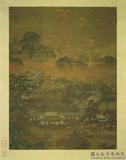明陳洪綬畫隱居十六觀 冊 孤往
推薦分享
資源連結
連結到原始資料 (您即將開啟新視窗離開本站)後設資料
- 資料識別:
- 故畫001162N000000014
- 資料類型:
- 類型:繪畫
- 型式:靜態圖像
- 著作者:
- 陳洪綬
- 主題與關鍵字:
- 高士(士人、隱士) 扇
- 出版者:
- 數位化執行單位:國立故宮博物院
- 格式:
- 本幅 21.4x29.8公分、全幅 71公分
- 關聯:
- 石渠寶笈初編(養心殿),上冊,頁492-493&*故宮書畫錄(卷六),第四冊,頁87-88&*故宮書畫圖錄,第二十三冊,頁238-243&* 陳洪綬,生平小傳另見。 畫中一載冠隱士,手執紈扇,踽踽獨行,除紈扇以淡綠敷染外,衣褶復以淡胭脂紅重描於墨線之上。此頁出於「隱居十六觀」第十四頁,陳洪綬於冊前,命題為「孤往」。按「孤往」字意,出於陶淵明「歸去來辭」中「懷良辰而孤往」,是以此圖為寫陶淵明像。老蓮一生頗好描繪陶淵明,然常別出心裁,畫中服飾,並無陶淵明之特徵。一般陶淵明畫像,常是優遊山林,而陳洪綬筆下,却常見苦惱悲憤表情,蓋借陶以自喻,却不脫個人世味痛苦之心。 &*Solitary Ambling Ch’en Hung-shou (1599-1652) Ming Dynasty (1368-1644) A recluse wearing a cap strolls alone, holding a large round fan. Only the palest washes tint this almost uncolored album leaf--pale green fills the outlines of the fan, while light umber traces the lines of the man’s robes. Solitary Ambling is the fourteenth leaf of the album Sixteen Views of Living in Seclusion, whose preliminary pages list the titles of the paintings within. The characters meaning “solitary ambling” (ku wang) appear in T’ao Yüan-ming’s poem Returning Home: “Embracing the fair weather I go on solitary ambles.” So the painting can be construed as a portrait of this poet. Ch’en often painted portraits of T’ao, but used them as mediums for depicting himself. In this one, for example, T’ao is not attired in his usual garb and he is not shown serenely strolling through the usual setting of forest and stream. Ch’en Hung-shou’s works often evince an air of bitterness and melancholy; here he has painted T’ao Yüan-ming as a metaphor of himself, and a sense of this sadness is still tangible. Ch’en Hung-shou, one of the most stylistically innovative artists of the late Ming, was a native of Chu-chi, Chekiang. &*1.王耀庭,〈明陳洪綬孤往〉,收入王耀庭編,《淵明逸致特展圖錄》(臺北:國立故宮博物院,1988年初版),頁109。
- 管理權:
- 國立故宮博物院
授權聯絡窗口
- 國立故宮博物院圖像授權、出版授權、影音資料授權-申請流程說明
http://www.npm.gov.tw/zh-TW/Article.aspx?sNo=03003061






